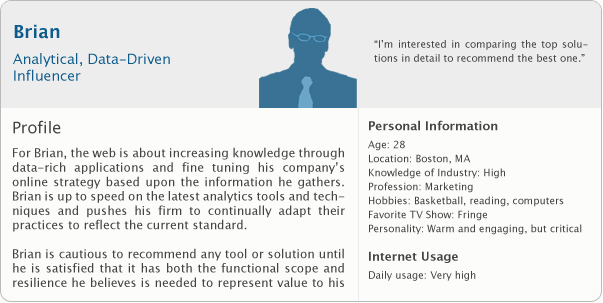You know that old gag where the husband gives his wife a bowling ball for her birthday? Or the much-reviled (but sadly true) stereotype of the overzealous soccer parents who are one outburst away from joining the game themselves? Each of these are classic examples of what happens when you make the mistake of thinking that something meant for someone else is all about you.
You’ve probably seen this happen plenty at work, too. I call it “client narcissism.” It manifests itself in many ways, but here’s an easy one: your client, a retailer, is spending weeks working out the details of the “About Us” section of their website, which they insist should be the second option in the main navigation. Instinctively, you sense that prioritizing that kind of inside information is off-point, but you don’t exactly know how to clue your client in. You could be blunt:
“Sorry, but tell the Vice President of such-and-such that the customers probably care just as little about who he is as he does about the sneakers his company sells.”
Right, try that one out if you’re comfortable with shedding a client or two. But if you want to keep your client—or better yet, continue to develop your consultative position with them—you’re definitely going to need to try something a bit more subtle and strategic.
If this scenario sounds familiar, that strategic approach is actually an opportunity to teach your client about web personas. Steve Mulder, author of The User is Always Right, defines a web persona as a “realistic personality profile that represents a significant group of your website’s users.” Even though creating consumer personas has been a common marketing practice for decades—with which your client may even have direct experience—applying the same principles to website planning tends to be overlooked. But without going through the process of web persona development, your client is much more prone to making guesses (at best) or assumptions (at worst) about who their prospects are. In most cases, their guesses/assumptions will really look more like them than anyone else. Creating web personas, whether they are specific, general, or behavioral, prevents us from mistakenly building websites for ourselves rather than those we want to serve.
Specific Web Personas
Depending upon the particular type of assessment process you use, identifying specific personas for a website could take a significant amount of time. Most approaches involve a series of interviews with employees and clients and ultimately produce several unique profiles. If you’ve been working solely with people in your client’s marketing department so far, the persona development phase might also be a good time to talk with some people in sales. Because they’re on the front lines, so to speak, they probably have an even clearer idea of who the real prospects are. However you approach it, a persona diagnostic will help to focus your client on what really matters for the project, rather than what they might think matters. But, if you don’t have the time or resources to do a persona discovery phase, you can still weave the basic concept in to your process by helping your client to focus on general and behavioral personas (more on that later).
If you do decide to try creating some specific web personas, we recommend creating 3-5 profiles, focusing on a qualitative assessment—akin to creating a story about your persona—rather than a quantitative one which results in a large and often unnecessarily peripheral data set. From start to finish, a qualitative approach will probably take you 2-4 weeks, whereas a quantitative approach could easily take twice that amount of time without representing a significant value gain to you in this planning process.
A Basic Persona Development Process
Creating web personas involves a four-step process of research, segmentation, creation and testing. To properly research personas, you’ll want to conduct one-on-one phone interviews with a group of active and valued clients as well as prospects familiar with you or your firm. Have another person on the call with you to listen and take notes so you can focus on having a natural conversation that covers the goals, attitudes and behaviors of your interviewee. Once you’ve completed your interviews, you’ll want to translate your interviewees into 3-5 segments. Segmenting personas is an intuitive, rather than scientific, process that generalizes your personas and qualifies them for uniqueness, realism, describability, user-base coverage, and influence upon the decisions you will make about your website during prototyping.

The persona documents you create (like the one shown above) should include basic identifiers, like a name, description, and photo of a representative user. Rather than referring to your personas by actual names from your interviewee pool, refer to them based upon their description (i.e. the “analytical influencer”). Your persona profiles should also include a longer description that focuses on what that person values and the way they make decisions as well as some personal information. Precision here is more important than accuracy. In other words, a realistic description is more important to your decision making than whether the description actually applies to the person upon whom you’ve based your persona. Finally, to test your personas, use and act out decision-making scenarios. A basic testing scenario might start with a search engine query for a description of your service or product (no specific names, though—we’re acting as people who don’t yet know about your firm) and follow the path from landing on your site’s homepage to finding a low level detail page and responding to a call to action. If you construct your site to allow for this kind of procedure, you’ll make better choices as to the types of content and calls to action that would be available based upon your personas.
General Web Personas
As I mentioned earlier, you don’t have to go “all the way” and follow Steve Muldur’s persona development process in order to start improving your website. Adopting the points of view of simpler, general web personas can do a great deal to make your website more effective.
For the most part, general web personas can be divided into two basic types: decision-makers and influencers. Most specific web personas are going to be decision-makers—the type of person who is looking to buy a product or service. These are the people who are looking for a solution that addresses an immediate problem, and are looking to implement it soon. For decision makers, key facts, specific benefits, pricing, and clear calls-to-action that will begin the purchasing process, are going to be essential.
On the other hand, influencers are the research-oriented users who are gathering information in order to help make a decision that is usually a bit farther off. Some might just be enthusiasts who will, some day, be in a decision-making position. For influencers, informational content—whether from blogs, articles, whitepapers, webinars, customer forums, etc.—and clear calls-to-action—to subscribe to various content channels or register for events—are going to be critical in engaging their long-term interest.
Behavioral Personas
Finally, consider two basic behavioral personas when planning the information architecture of a website. These are very simple: some users are browsing-oriented, and will tend toward exploring a website’s menus in order to gain an understanding of its contents, while others are search-oriented, and will almost immediately use a website’s search tools in order to determine if it contains what they are looking for. These personas are independent of any industry or genre, so you need to enable the website you are working on to be friendly to both.
By now you’ve probably identified some web personas of your own, and perhaps even some flaws in your website that are much more obvious now with those personas in mind. Pointing out that simple connection, that a certain person is not being served well by some particular aspect of the site, is one way to get the persona conversation going with your client. But chances are also good that a site designed and built without taking personas into account will quickly garner negative feedback and prompt the conversation once it’s a bit too late. In fact, that first unconsidered user will probably have a reaction similar to the wife who was given a bowling ball for her birthday, which I’ll just let you imagine for yourself…


